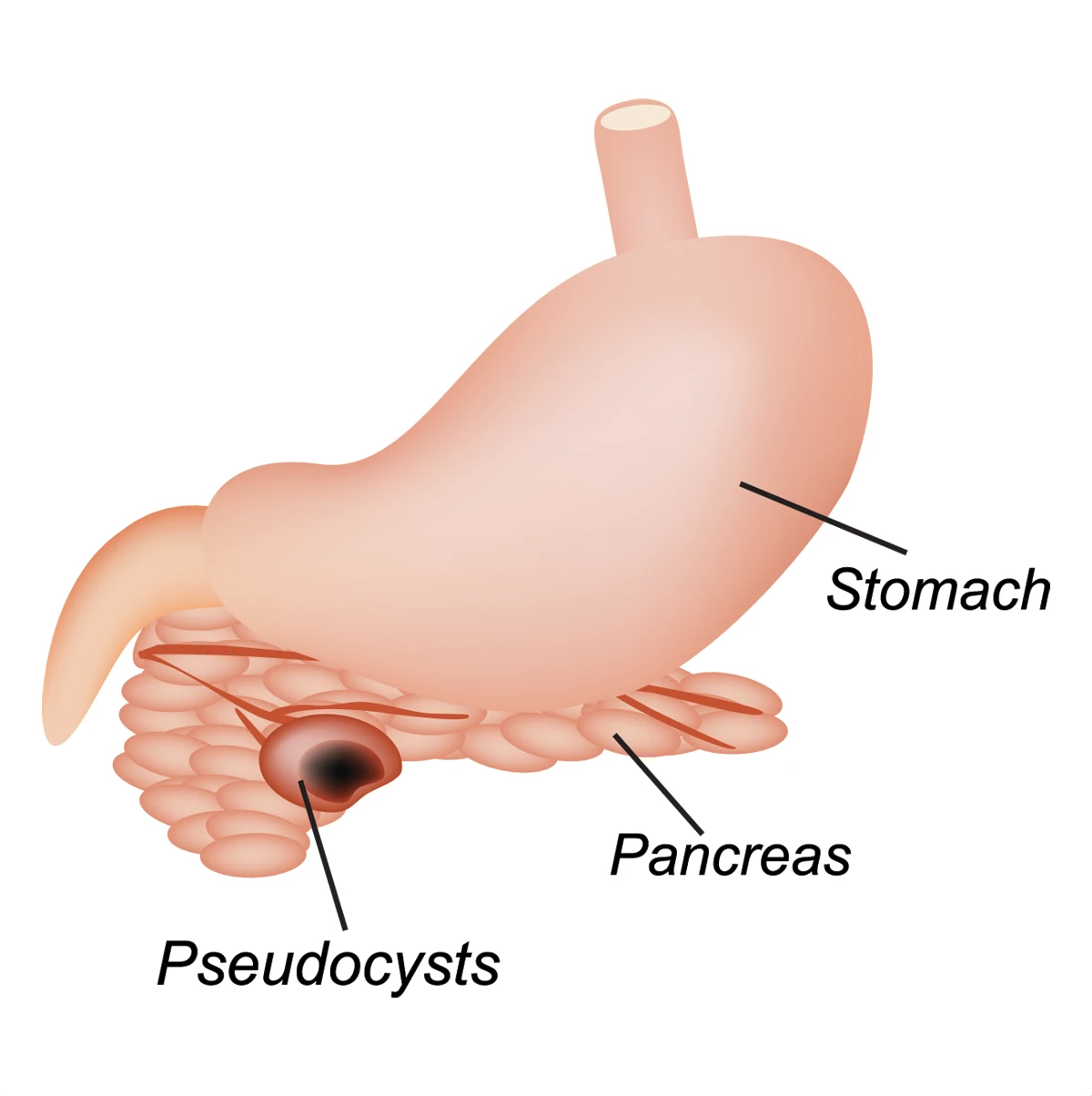Pancreatic pseudocyst
If you have an acute or chronic case of pancreatitis, you may develop a common type of cyst in your pancreas called a pancreatic pseudocyst. This type of cyst is benign (noncancerous) but often requires treatment to prevent severe complications. Pseudocysts can be hard to diagnose since their symptoms are similar to other conditions that affect the abdominal area.
What is a pancreatic pseudocyst?

A pseudocyst is a round or oval fluid-filled cyst found inside your pancreas. Your pancreas sits inside your abdomen, below your stomach. As part of your digestive system, your pancreas contains a gland that releases digestive enzyme fluids that help you digest food and hormones to regulate blood sugar levels.
When your pancreas is injured or inflamed, the pancreatic ducts that drain your digestive enzyme fluids become blocked. The excess fluid builds up inside your pancreas, forming a pseudocyst.
Differences between pancreatic pseudocysts, cysts and abscesses
It’s possible to develop pancreatic cysts or abscesses, which differ from pancreatic pseudocysts in their appearance and treatment. While all are made from fluid, abscesses also contain semisolid parts. Pseudocysts, which are rarely cancerous, look like a cyst but aren't made from the same tissue as a true cyst, which could be cancerous.
What causes pancreatic pseudocysts?
Pseudocysts form when your pancreas is inflamed or injured due to pancreatitis – a condition that causes inflammation in your pancreas. If you have a sudden (acute) or chronic case of pancreatitis, the swelling injures and inflames the cells inside your pancreas.
When your pancreas is injured, the digestive enzyme fluids that your pancreas makes leak and build up inside the pancreas, leading to the formation of a pseudocyst.
Pancreatic pseudocyst symptoms
Symptoms may occur right after a severe case of pancreatitis, or months after. In some cases, you may not have any noticeable symptoms related to your pseudocyst. Moderate to severe symptoms include:
- Severe or constant pain in your abdomen, which can also be felt in your back
- Bloating of the abdomen
- Nausea and vomiting
- Fever
- Loss of appetite
- Difficulty eating or digesting food
Pancreatic pseudocyst complications
Complications from a pseudocyst are rare. However, pseudocysts can cause life-threatening complications that you would need to seek emergency care for. This includes bleeding due to a rupture or sepsis and shock from an infection. Other risks of untreated pseudocysts include:
- Obstructive jaundice, caused by the cyst blocking a bile duct in your pancreas.
- Portal hypertension, the elevation of the blood pressure in your portal vein (major vein that leads to your liver).
- Gastric outlet obstruction, which happens when a sizable pseudocyst adds pressure to the pancreas and limits gastric emptying.
Pancreatic pseudocyst risk factors
Anyone with pancreatitis can get a pseudocyst, although its more common in men than women. The most common risk factors for developing pancreatitis – and possibly a pancreatic pseudocyst – are having gallstones and heavy alcohol use. Other risk factors include:
- Abdominal injury or trauma
- Pancreatic tumor or infection
- Cystic fibrosis
- Autoimmune diseases
You can decrease your risk by seeking treatment for your pancreatitis and making healthy lifestyle adjustments.
Diagnosing pancreatic pseudocysts
If you have symptoms of a pseudocyst, your provider will start with a physical exam. They will feel your abdomen to check for a lump, which can sometimes be felt if you have a large pseudocyst. Often, imaging tests on your abdomen will be needed to properly provide a diagnosis and rule out other causes of your symptoms. These tests may include a CT scan or MRI.
If these tests don’t show clear results, your provider may use noninvasive interventional endoscopy methods to get a clearer picture of your pancreas or get a sample of the fluid in your cyst to examine.
Pancreatic pseudocyst treatment
Some pancreatic pseudocysts go away on their own without treatment, so your provider may only want to monitor your pseudocyst over time. However, treatment is commonly recommended – especially if you have symptoms and your pseudocyst is large.
Pancreatic pseudocyst drainage is the most common treatment option. This is done through surgical and nonsurgical methods. The most common method is through minimally invasive endoscopic-assisted drainage, which offers faster treatment and recovery, as well as a lower risk for complications compared to traditional surgery. Other methods for drainage include:
- CT scan: A needle is guided through the skin to drain the fluid, guided by a CT scan.
- Percutaneous catheter: A hollow tube is inserted into the body, which drains the fluid.
- Laparoscopic surgery: A laparoscope is used, requiring a small incision in the body, to drain the fluid.
Recovery after pancreatic pseudocyst treatment depends on your treatment method. Your provider may want to see you for follow up imaging tests to confirm the pseudocyst has gone away.
Get care
We help you live well. And we’re here for you in person and online.
